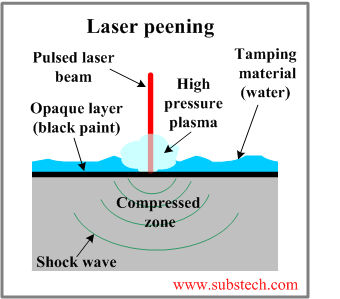Main page
About us
Sliding Bearings Consulting
Advertising Opportunities

to Metals
to Metal forming technologies
Laser peening
Dr. Dmitri Kopeliovich
 Laser peening is a cold work process, in which the metal part is struck by a high energy pulsed laser beam producing high amplitude stress waves.
Laser peening is a cold work process, in which the metal part is struck by a high energy pulsed laser beam producing high amplitude stress waves.
The surface material resists to stretching induced by the stress waves resulting in a formation of a compression stressed skin.
A typical laser system used for laser peening has the following parameters:
- Laser wavelength is about 0.04 µinch (1 µm).
- Pulse duration 10-50 nanoseconds.
- Pulse energy 50-100 joules.
- Beam diameter 0.2” (5 mm).
Prior to laser peening the material surface is plated with an opaque layer of black paint, metal foil or tape. The black layer is then covered with a transparent overlay (commonly flowing water).
The material of the black layer has low heat of vaporization. When the laser strikes the workpiece surface the pulses energy is absorbed by the opaque material, which heats up, vaporizes and forms a high temperature plasma. The plasma gas is trapped between the workpiece surface and the transparent water layer limiting the thermal expansion of the gas. As a result the gas pressure increases to extremely high value. The high pressure is transmitted to the workpiece material producing a shock wave, which travels through the part material and generates compression stress.
Effect of laser peening is cold work (not heating nor melting).
The purpose of water is to confine the high pressure plasma gas (not cooling the workpiece surface).
The depth of the residual compression stress layer produced by laser peening is over 0.04” (1 mm), which is 4-5 times deeper than the compressed zone produced by Shot peening.
The residual compression stresses inhibits both crack initiation and propagation. Therefore laser peening is used mainly for increasing fatigue strength. Due to deeper penetration of the compression stress zone laser peening provides higher effect on surface related properties as compared to shot peening.
Steels, nodular (ductile) cast irons, sintered iron alloys, Aluminum alloys, Nickel alloys and Titanium alloys may be treated by laser peening.
The properties, which may be increased by laser peening:
- Resistance to Intergranular corrosion
The components, which are normally laser peened: aircraft gas turbine engine fan blades, airframe structures, helicopter transmission gears, jet engine rotors, disks, gears and shafts, oil tools (drill collars, bits, mud pumps).
to top
Related internal links


